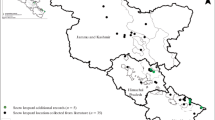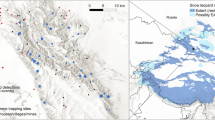Abstract
Habitat suitability models based on particular environmental variables are increasingly being used to predict occurrence of species for wildlife management issues. A variety of techniques and statistical methods are used in species distribution modelling. In this case we use MaxEnt and data on the distribution of snow leopard in Nepal based on a large set of occurrence data collected from a much wider range of areas (9 districts) than in the previous studies. We used camera traps, scat collections and monitoring of fresh pugmarks and scrapes. All our data based on scats were consistently genotyped to avoid misidentification of the species that produced them. All fresh pugmarks and scrapes were verified whether they originate from snow leopard by using movement pattern of snow leopard from camera trap data. Altitude and annual mean temperature are important common factors contributing to snow leopard habitat suitability within the area studied, indicated by both the percentage contribution of environmental variables and jackknife test from MaxEnt model. Some other uncommon factors also seem to play a role as they were important in at least one of the analyses. These were: distance from roads and precipitation of the driest month; however, their importance has to be considered with caution. To conclude: the habitat suitability models indicate that the main danger for snow leopard survival may be climate change and human expansion. Both these phenomena will push the lower limit of its distribution upwards to higher elevations, which will entail two negative effects.
Access this chapter
Tax calculation will be finalised at checkout
Purchases are for personal use only
Similar content being viewed by others
References
Aarts G, MacKenzie M, McConnell B, Fedak M, Matthiopoulos J (2008) Estimating space-use and habitat preference from wildlife telemetry data. Ecography 31:140–160. https://doi.org/10.1111/j.2007.0906-7590.05236.x
Alexander JS, Shi K, Tallents LA, Riordan P (2016) On the high trail: Examining determinants of site use by the endangered snow leopard Panthera uncia in Qilianshan, China. Oryx 50:1–8
Aryal A, Brunton D, Ji WH, Karmacharya D, McCarthy T, Bencini R, Raubenheimer D (2014) Multipronged strategy including genetic analysis for assessing conservation options for the snow leopard in the Central Himalaya. J Mammal 95:871–881
Aryal A, Shrestha UB, Ji WH, Ale SB, Shrestha S, Ingty T, Maraseni T, Cockfield G, Raubenheimer D (2016) Predicting the distributions of predator (snow leopard) and prey (blue sheep) under climate change in the Himalaya. Ecol Evol 6:4065–4075
Atzeni L, Cushman SA, Bai D, Wang J, Chen P, Shi K, Riordan P (2020) Meta-replication, sampling bias, and multi-scale model selection: a case study on snow leopard (Panthera uncia) in western China. Ecol Evol 10:7686–7712. https://doi.org/10.1002/ece3.6492
Bacon L, Hingrat Y, Jiguet F, Monnet AC, Sarrazin F, Robert A (2017) Habitat suitability and demography, a time dependent relationship. Ecol Evol 7:2214–2222
Bai DF, Peng-Ju Chen PJ, Atzeni L, Cering L, Li Q, Shi K (2018) Assessment of habitat suitability of the snow leopard (Panthera uncia) in Qomolangma National Nature Reserve based on MaxEnt modelling. Zool Res 39:73–386. https://doi.org/10.24272/j.issn.2095-8137.2018.057
Bakkenes M, Eickhout B, Alkemade R (2006) Impacts of different climate stabilization scenarios on plant species in Europe. Glob Environ Change 16:19–28
Beyer HL, Haydon DT, Morales JM, Frair JL, Hebblewhite M, Mitchell M, Matthiopoulos J (2010) The interpretation of habitat preference metrics under use-availability designs. Phil Trans R Soc B 365:2245–2254. https://doi.org/10.1098/rstb.2010.0083
Boyce M, McDonald L (1999) Relating populations to habitats using resource selection functions. Trends Ecol Evol 14:268–272. https://doi.org/10.1016/s0169-347(99)01593-1
Ciarniello LM, Boyce MS, Heard DC, Seip DR (2007) Components of grizzly bear habitat selection: density, habitats, roads, and mortality risk. J Wildlife Manag 71:1446–1457
CMDN (2010) Population monitoring of snow leopard in Nepal by non-invasive molecular scatology: a pilot project. A technical report submitted by Center for Molecular Dynamics-Nepal to WWF-Nepal, Kathmandu Nepal
Collinge S (2010) Spatial ecology and conservation. Natl Educ Knowl 3:69
Corsi F, De Leeuw J, Skidmore A (2000) Modelling species distribution with GIS. In: Boitan L, Fuller TK (eds) Research techniques in animal ecology; controversies and consequences. Columbia University Press, New York, pp 389–434
Elith J, Graham CH, Anderson RP, Dudík M, Ferrier S et al (2006) Novel methods improve prediction of species’ distributions from occurrence data. Ecography 29:129–151
Fick SE, Hijmans RJ (2017) WorldClim 2: new 1-km spatial resolution climate surfaces for global land areas. Int J Clim 37:4302–4315
Fox JL (1994) Snow leopard conservation in the wild – a comprehensive perspective on a low density and highly fragmented population. In: Fox JL, Du JZ (eds) Proceedings of the 7th international snow leopard symposium. Xining, Qinghai, China, 25–30 July, 1992. International Snow Leopard Trust, Seattle, Washington, pp 3–15
Franklin J (2009) Mapping species distributions: Spatial inference and prediction. Cambridge University Press, Cambridge, UK
Guisan A, Zimmerman NE (2000) Predictive habitat distribution models in ecology. Ecol Model 135:147–186
Hirzel AH, Lay GL (2008) Habitat suitability modelling and niche theory. J Appl Ecol 45:1272–1381
Hirzel AH, Lay GL, Helfer V, Randin C, Guisan A (2006) Evaluating the ability of habitat suitability models to predict species presences. Ecol Model 199:142–152
Holt C, Nevin O, Smith D, Convery I (2018) Environmental niche overlap between snow leopard and four prey species in Kazakhstan. Ecol Inform 48:97–103. https://doi.org/10.1016/j.ecoinf.2018.09.005
Hunter DO, Jackson R (1997) A range-wide model of potential snow leopard habitat. In: Jackson R, Ahmad A (eds) Proceedings of the 8th International Snow Leopard Symposium. International Snow Leopard Trust and World Wildlife Fund-Pakistan, pp 51–56
Jackson R (1996) Home range, movements and habitat use of snow leopard in Nepal. PhD Thesis, University of London, UK
James ARC, Stuart-Smith AK (2000) Distribution of caribou and wolves in relation to linear corridors. J Wildlife Manag 64:154–159
Johnson A, Vongkhamheng C, Hedemark M, Saithongdam T (2006) Effects of human-carnivore conflict on tiger (Panthera tigris) and prey populations in Lao PDR. Anim Conserv 9:421–430
Kaartinen S, Kojola I, Colpaert A (2005) Finnish wolves avoid roads and settlements. Ann Zool Fennici 42:523–532
Kalashnikova YA, Karnaukhov AS, Dubinin MY, Poyarkov AD, Rozhnov VV (2019) Potential habitat of snow leopard (Panthera uncia, Felinae) in south Siberia and adjacent territories based on the maximum entropy distribution model. Зooлoгичecкий Жypнaл (zoologicheskii Zh) 98:332–342. https://doi.org/10.1134/S0044513419030061
Kellner CJ, Brawn JD, Karr JR (1992) What is habitat suitability and how should it be measured? In: McCullough DR, Barrett RH (eds) Wildlife 2001: populations. Springer, Dordrecht, pp 476–488
Khatiwada JR, Ghimerey Y (2008) Status survey of snow leopard (Uncia uncia) in Humla District, Western Nepal. A technical report submitted to WWF-Nepal, Kathmandu, Nepal
Kie JG, Matthiopoulos J, Fieberg J, Powell RA, Cagnacci F, Mitchell MS, Gaillard JM, Moorcroft PR (2010) The home-range concept: are traditional estimators still relevant with modern telemetry technology? Phil Trans R Soc B 365:2221–2231. https://doi.org/10.1098/rstb.2010.0093
Lavergne S, Mouquet N, Thuiller W, Ronce O (2010) Biodiversity and climate change: integrating evolutionary and ecological responses of species and communities. Ann Rev Ecol Evol Syst 41:321–350
Li J (2013) Ecology and conservation strategy of snow leopard (Panthera uncia) in Sangjiangyuan area on the Tibetan Plateau. PhD thesis, Peking University, Beijing (in Chinese)
Li J, McCarthy TM, Wang H, Weckworth BV, Schaller GB, Mishra C, Lu Z, Beissinger SR (2016) Climate refugia of snow leopards in High Asia. Biol Conserv 203:188–196
Linkie M, Chapron G, Martyr DJ, Holden J, Leaderwilliams N (2006) Assessing the viability of tiger subpopulations in a fragmented landscape. J Appl Ecol 43:576–586
Manly BFJ, McDonald LL, Thomas DL, MacDonald TL, Erickson WP (2002) Resource selection by animals. In: Statistical design and analysis for field studies, 2nd edn. Kluwer Academic Publisher, London.
McCarthy T, Mallon D, Philip JN (2016) Snow leopard. Biodiversity of the world: conservation from genes to landscapes. Elsevier, San Diego
McCarthy TM, Fuller TK, Munkhtsog B (2005) Movements and activities of snow leopards in Southwestern Mongolia. Biol Conserv 124:527–537
McCullagh P, Nelder JA (1989) Generalized linear models, 2nd edn. Chapman and Hall/CRC. Washington, DC. https://doi.org/10.1007/978-1-4899-3242-6
Ottaviani D, Lasinio GJ, Boitani L (2004) Two statistical methods to validate habitat suitability models using presence-only data. Ecol Model 179:417–443
Phillips JS, Dudík M, Schapire RE (2018) MaxEnt software for modelling species niches and distributions (Version 3.4.1). Available from http://biodiversityinformatics.amnh.org/open_source/MaxEnt/. Accessed on 4 Oct 2018
Phillips S, Dudík M (2008) Modeling of species distributions with Maxent: new extensions and a comprehensive evaluation. Ecography 31: 161–175
Phillips SJ, Anderson RP, Schapire RE (2006) Maximum entropy modelling of species geographic distributions. Ecol Model 190:231–259
Purvis A, Gittleman JL, Cowlishaw G, Mace GM (2000) Predicting extinction risk in declining species. Proc R Soc B Biol Sci 267:1947–1952. https://doi.org/10.1098/rspb.2000.1234
Ripley BD (1996) Pattern recognition and neural networks. Cambridge University Press, Cambridge. https://doi.org/10.1017/CBO9780511812651
Schaller GB (1977) Mountain monarchs: wild sheep and goats of the Himalaya. University of Chicago Press, Chicago, Illinois
Scott JM, Heglund PJ, Morrison ML, Haufler JB, Raphael MG, Wall WA, Samson FB (eds) (2002) Predicting species occurrences: issues of scale and accuracy. Island Press, Washington, DC
Sharma RK, Bhatnagar YV, Mishra C (2015) Does livestock benefit or harm snow leopards? Biol Conserv 190:8–13
Shrestha B (2006) Status, distribution and potential habitat of Himalayan tahr (Hemitragus jemlahicus) and conflict areas with livestock in Sagarmatha National Park, Nepal. N J Sci Tech 7:27–33
Shrestha B (2008) Presence/absence and relative abundance survey of snow leopard in Makalu Barun National Park and Rolwaling of Dolakha district of sacred Himalayan landscape. A technical report submitted to WWF-Nepal, Kathmandu Nepal
Shrestha B, Aihartza J, Kindlmann P (2018) Diet and prey selection by snow leopards in the Nepalese Himalayas. PLoS ONE 13:e0206310. https://doi.org/10.1371/journal.pone.-0206310
Warren DL, Glor RE, Turelli M (2010) ENM Tools: a toolbox for comparative studies of environmental niche models. Ecography 33:607–611
Watts SM, McCarthy TM, Namgail T (2019) Modeling potential habitat for snow leopards (Panthera uncia) in Ladakh, India. PLoS ONE 14:e0211509. https://doi.org/10.1371/journal.pone.0211509
Whittington J, St. Clair CC, Mercer G (2005) Spatial responses of wolves to roads and trails in mountain valleys. Ecol Appl 15:543–553
Wolf M, Ale S (2009) Signs at the top: habitat features influencing snow leopard Uncia uncia activity in Sagarmatha National Park, Nepal. J Mammal 90:604–611
WWF-Nepal (2009) Estimating snow leopard populations in the Nepal Himalaya. World Wildlife Fund-Nepal, Kathmandu
Xu F, Ma M, Yang WK, Blank D, Wu YQ, McCarthy T, Munkhtsog B (2012) Winter habitat use of snow leopards in Tomur national nature reserve of Xinjiang, Northwest China. J Arid Land 4:191–195
Yi YJ, Cheng X, Yang ZF, Zhang SH (2016) MaxEnt modeling for predicting the potential distribution of endangered medicinal plant (H. riparia Lour) in Yunnan, China. Ecol Eng 92:260–269
Author information
Authors and Affiliations
Corresponding author
Editor information
Editors and Affiliations
Rights and permissions
Copyright information
© 2022 Springer Nature Switzerland AG
About this chapter
Cite this chapter
Shrestha, B., Kindlmann, P. (2022). Assessment of the Suitability of Particular Areas in Nepal for Snow Leopard Based on MaxEnt Modelling. In: Kindlmann, P. (eds) Snow Leopards in Nepal. Springer, Cham. https://doi.org/10.1007/978-3-031-11355-0_6
Download citation
DOI: https://doi.org/10.1007/978-3-031-11355-0_6
Published:
Publisher Name: Springer, Cham
Print ISBN: 978-3-031-11354-3
Online ISBN: 978-3-031-11355-0
eBook Packages: Biomedical and Life SciencesBiomedical and Life Sciences (R0)




